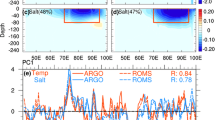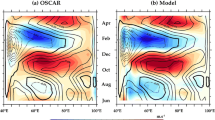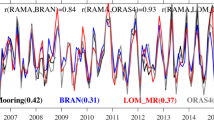Abstract
The variability of subsurface currents in the equatorial Indian Ocean is studied using high resolution Ocean General Circulation Model (OGCM) simulations during 1958–2009. February–March eastward equatorial subsurface current (ESC) shows weak variability whereas strong variability is observed in northern summer and fall ESC. An eastward subsurface current with maximum amplitude in the pycnocline is prominent right from summer to winter during strong Indian Ocean Dipole (IOD) years when air-sea coupling is significant. On the other hand during weak IOD years, both the air-sea coupling and the ESC are weak. This strongly suggests the role of ESC on the strength of IOD. The extension of the ESC to the summer months during the strong IOD years strengthens the oceanic response and supports intensification and maintenance of IODs through modulation of air sea coupling. Although the ESC is triggered by equatorial winds, the coupled air-sea interaction associated with IODs strengthens the ESC to persist for several seasons thereby establishing a positive feedback cycle with the surface. This suggests that the ESC plays a significant role in the coupled processes associated with the evolution and intensification of IOD events by cooling the eastern basin and strengthening thermocline-SST (sea surface temperature) interaction. As the impact of IOD events on Indian summer monsoon is significant only during strong IOD years, understanding and monitoring the evolution of ESC during these years is important for summer monsoon forecasting purposes. There is a westward phase propagation of anomalous subsurface currents which persists for a year during strong IOD years, whereas such persistence or phase propagation is not seen during weak IOD years, supporting the close association between ESC and strength of air sea coupling during strong IOD years. In this study we report the processes which strengthen the IOD events and the air sea coupling associated with IOD. It also unravels the connection between equatorial Indian Ocean circulation and evolution and strengthening of IOD.











Similar content being viewed by others
References
Carton JA, Giese BS (2008) A reanalysis of ocean climate using simple ocean data assimilation (SODA). Mon Weather Rev 136:2999–3017
Chen G, Han W, Li Y, Wang D, McPhaden MJ (2015) Seasonal-to-interannual time scale dynamics of the equatorial undercurrent in the Indian ocean. J Phys Oceanogr 45:1532–1553. doi:10.1175/JPO-D-14-0225.1
Chowdary JS, Gnanaseelan C, Xie SP (2009) Westward propagation of barrier layer formation in the 2006–07 Rossby wave event over the tropical southwest Indian ocean. Geophys Res Lett 36(4):L04607. doi:10.1029/2008GL036642
Deshpande A, Chowdary JS, Gnanaseelan C (2014) Role of thermocline–SST coupling in the evolution of IOD events and their regional impacts. Clim Dyn 43:163–174. doi:10.1007/s00382-013-1879-5
Gadgil S, Vinayachandran PN, Francis A, Gadgil S (2004) Extremes of the Indian summer monsoon rainfall, ENSO and equatorial Indian Ocean oscillation. Geophys Res Lett 31:L12213. 10.1029/2004GL019733
Gnanaseelan C, Vaid BH (2010) Interannual variability in the Biannual Rossby waves in the tropical Indian ocean and its relation to Indian ocean dipole and El Niño forcing. Ocean Dyn 60(1):27–40
Gnanaseelan C, Vaid BH, Polito PS (2008) Impact of biannual Rossby waves on the Indian ocean dipole. IEEE Geosci Remote Sens Lett 5(3):427–429
Gnanaseelan C, Deshpande A, McPhaden MJ (2012) Impact of Indian ocean dipole and El niño/southern oscillation forcing on the Wyrtki jets. J Geophys Res 117:C08005. doi:10.1029/2012JC007918
Griffies SM, Biastoch A, Böning C et al (2009) Coordinated ocean-ice reference experiments (COREs). Ocean Model 26(1–2):1–46. doi:10.1016/j.ocemod.2008.08.007
Iskandar I, Masumoto Y, Mizuno K (2009) Subsurface equatorial zonal current in the eastern Indian ocean. J Geophys Res 114:C06005. doi:10.1029/2008JC005188
Izumo T (2005) The equatorial undercurrent, meridional overturning circulation, and their roles in mass and heat exchanges during El Niño events in the tropical Pacific ocean. Ocean Dyn 55:110–123. DOI:10.1007/s10236-005-0115-1
McPhaden MJ, Meyers G, Ando K, Masumoto Y, Murty VSN, Ravichandran M, Syamsudin F, Vialard J, Yu L, Yu W (2009) RAMA: the research moored array for African–Asian–Australian monsoon analysis and prediction. Bull Amer Meteor Soc 90:459–480. doi:10.1175/2008BAMS2608.1
Nyadjro E, McPhaden MJ (2014) Variability of zonal currents in the eastern equatorial Indian ocean on seasonal to interannual time scales. J Geophys Res 119:7969–7986. doi:10.1002/2014JC010380
Rahul S, Gnanaseelan C (2016) Can large scale surface circulation changes modulate the sea surface warming pattern in the Tropical Indian ocean? Clim Dyn 46:3617–3632. doi:10.1007/s00382-015-2790-z
Reppin J, Schott FA, Fischer J, Quadfasel D (1999) Equatorial currents and transports in the upper central Indian ocean: annual cycle and interannual variability. J Geophys Res 104:15,495–15,514. doi:10.1029/1999JC900093
Saji NH, Goswami BN, Vinayachandran PN, Yamagata T (1999) A dipole mode in the tropical Indian ocean. Nature 401:360–363
Sayantani O, Gnanaseelan C (2015) Tropical Indian Ocean subsurface temperature variability and the forcing mechanisms. Clim Dyn 44:2447–2462. doi:10.1007/s00382-014-2379-y.
Schott F, McCreary JP (2001) The monsoon circulation of the Indian ocean. Prog Oceanogr 51:1–123
Schott F, Xie SP, McCreary JP (2009) Indian ocean circulation and climate variability. Rev Geophys 47:1–46. doi:10.1029/2007RG000245.1
Swapna P, Krishnan R (2008) Equatorial undercurrents associated with Indian ocean dipole events during contrasting summer monsoons. Geophys Res Lett 35:L14S04. doi:10.1029/2008GL033430
Thompson B, Gnanaseelan C, Salvekar PS (2006) Variability in the Indian ocean circulation and salinity and its impact on SST anomalies during dipole events. J Marine Res 64:853–880. doi:10.1357/002224006779698350
Vinayachandran PN, Saji NH, Yamagata T (1999) Response of the equatorial Indian Ocean to an unusual wind event during 1994. Geophys Res Lett 26(11):1613–1616. doi:10.1029/1999GL900179
Webster PJ, Moore AW, Loschnigg JP, Leben RR (1999) Coupled ocean-atmosphere dynamics in the Indian ocean during 1997–1998. Nature 401:356–360
Wyrtki K (1973) An equatorial jet in the Indian ocean. Science 181:262–264
Xie SP, Annamalai H, Schott FA, McCreary JP (2002) Structure and mechanisms of South Indian ocean climate variability. J Clim 15:864–878
Zhang D, McPhaden MJ, Lee T (2014) Observed interannual variability of zonal currents in the equatorial Indian ocean thermocline and their relation to Indian ocean dipole. Geophys Res Lett 41:7933–7941. doi:10.1002/2014GL061449
Acknowledgements
The authors acknowledge the support of Director, ESSO-IITM. The valuable suggestions from the anonymous reviewers helped us to improve the manuscript. We also thank GFDL for MOM5 code and S. Rahul for the model simulations.
Author information
Authors and Affiliations
Corresponding author
Rights and permissions
About this article
Cite this article
Gnanaseelan, C., Deshpande, A. Equatorial Indian Ocean subsurface current variability in an Ocean General Circulation Model. Clim Dyn 50, 1705–1717 (2018). https://doi.org/10.1007/s00382-017-3716-8
Received:
Accepted:
Published:
Issue Date:
DOI: https://doi.org/10.1007/s00382-017-3716-8




